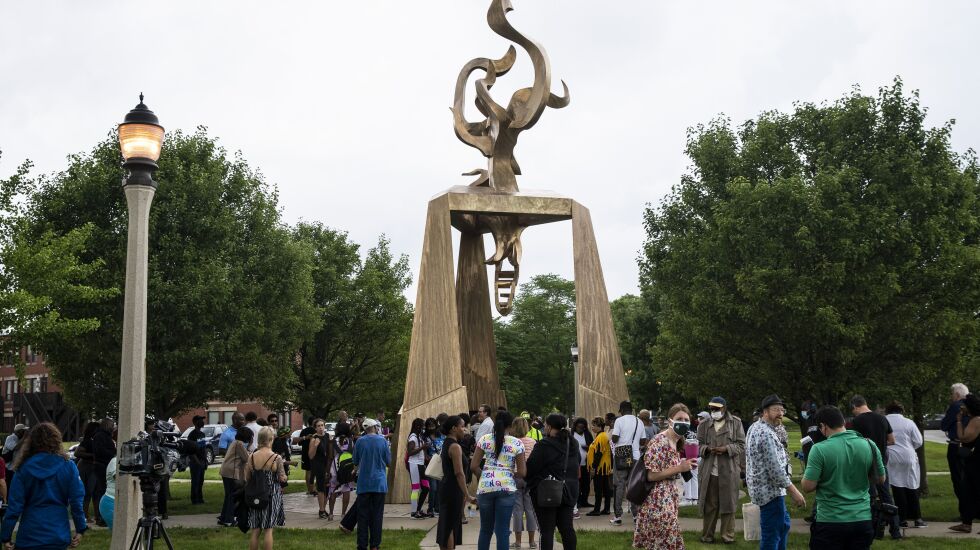
Abstract sculptor Richard Hunt, a lifelong Chicagoan who in 1971 became the first African American artist to receive a solo retrospective at New York’s Museum of Modern Art, died Saturday at age 88.
Hunt “passed away peacefully” at his Chicago home, according to a statement posted to his website. A cause wasn’t released.
“Richard Hunt was a preeminent American sculptor and public artist with a remarkable career spanning 70 years,” said Charles Loving, author of a 2012 book on the artist. “His evocative works are immediately recognizable for melding the gritty muscularity of America’s industrial-urban environment with a passion for natural forms and biology.”
Hunt created fluidly organic, welded-metal sculptures in a constructivist style descended from the 1920s and ‘30s creations of Pablo Picasso and Julio González. As a student, he was transformed by the discovery of González’s work at “Sculpture of the 20th Century,” a 1953 show at the Art Institute of Chicago.
The Chicago sculptor, who worked in Lincoln Park since 1971 in a cavernous, former electrical substation built in 1909, is best known for his large-scale public works. He placed more than 160 such commissions across the United States, including the 30-foot-wide hanging bronze, “Swing Low,” at the National Museum of African American History and Culture, and was responsible for 35 pieces in the Chicago area.
In a statement Saturday, President Barack Obama said Hunt’s sculpture, “Book Bird,” will sit outside a new branch of the Chicago Public Library at the Obama Presidential Center and “be an inspiration for visitors from around the world, and an enduring reminder of a remarkable man.”

As lead-ups to his 80th birthday, Hunt was featured in two Chicago-area exhibitions in 2014, a compact showcase at the Museum of Contemporary Art Chicago and a career survey, “Richard Hunt: 60 Years of Sculpture,” at the Chicago Cultural Center.
“His ability to put challenging, personal, abstract forms in a public setting,” Daniel Schulman, curator of the Cultural Center show, said at the time, “and to do it over a long period, and to do it freshly, and with the ability to engage the public in larger metaphorical issues, makes him a really important sculptor.”
Hunt’s vertical sculptures, such as the 55-foot-tall “And You Seas” in St. Joseph, Mich., have a lithe, upswept trajectory that suggests transcendence and freedom. At the same time, he made horizontal, low-slung works, such as the bulldozer-like “Harlem Hybrid” (1976), a New York City commission that was restored in 2008.
“Hero Construction” (1958), a 64-inch-tall figurative steel sculpture, has a prominent spot on a landing of the Woman’s Board Grand Staircase at the Art Institute, where Hunt had a survey exhibition in 2020-21.
While the sculptor’s works are abstract, they draw on nature, African art (he had a substantial collection) and a range of modern art movements, include cubism, surrealism and expressionism, and they make references to African-American history and Greco-Roman mythology.
“He’s come up with a very powerful way to describe in visual terms America’s unique hybridized cultural experience,” said Loving, the retired director of the Snite Museum of Art (now Raclin Murphy Museum of Art) at the University of Notre Dame, which houses a major holding of Hunt’s work.
Born on Chicago’s South Side in 1935, Hunt showed artistic promise early on, taking lessons at the South Side Community Art Center and the Junior School of the Art Institute of Chicago. He went on to enroll at the School of the Art Institute of Chicago.

While he was still a student, the Museum of Modern Art acquired one of his works, immediately marking him as an artist to watch. When he was just 35, that same museum honored him with a mid-career retrospective, drawing an appreciative review from the New York Times.
Hunt was strongly influenced by the famed 50-foot-tall Picasso sculpture that was installed in 1967 in Daley Plaza. In 2016, the Sun-Times asked several Chicago artists and curators to name their favorite public artwork in the Windy City, and Hunt chose that piece.
“Beyond the ways and means of developing and producing the Chicago Picasso was the insight that something that began as a piece of work personal to an artist could become a grand enhancement of a civic space, a three-dimensional expression of the city’s cultural ambition,” Hunt wrote.

A descendant of slaves brought to the United States via the port of Savannah, Ga., Hunt attended the funeral of Emmett Till, who grew up just a few blocks from him. A lifelong advocate for equity and inclusion, Hunt recently completed a model for a monument to Till that is to be installed at the childhood home of the civil rights icon.
Appointed by Lyndon Johnson in 1968, Hunt was the first African American visual artist to serve on the National Council on the Arts. In 1981, he was one of eight jurors for the Vietnam Veteran Memorial competition in Washington, D.C., which was won by Maya Lin.
Hunt received 18 honorary degrees and more than 30 major awards, including the Lifetime Achievement Award from the International Sculpture Center, Fifth Star Award from the City of Chicago and Legends and Legacy Award from the Art Institute.
A comprehensive monograph on Hunt was published in 2022, the same year that the Getty Research Institute, part of the Getty Center in Los Angeles, Calif., acquired the Richard Hunt Archive, with more than 800 linear feet of papers and other materials.
Private funeral arrangements are pending. A public celebration of his art and life will be held in Chicago in the spring.











